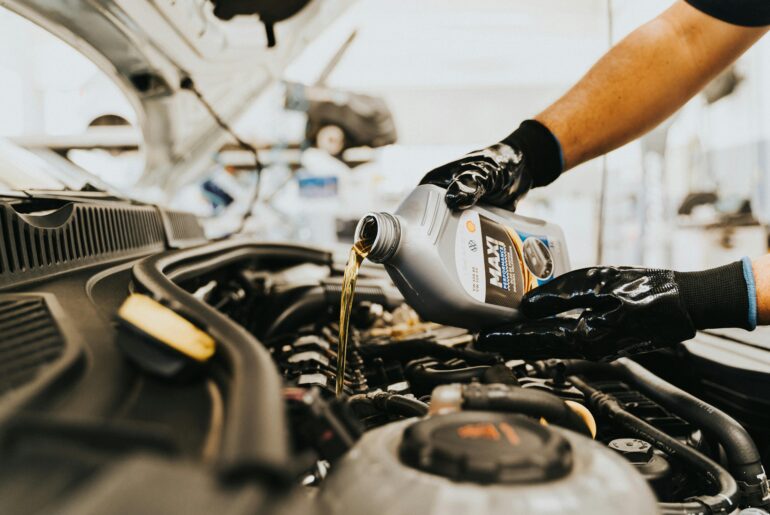- The average cost of an oil change in the U.S. is about $35 to $75. However, it can rise to $100 or more depending on several factors.
- The type of oil used matters significantly. Conventional oil is cheaper, but full synthetic oil is the most expensive.
- Other factors that affect the price include your vehicle’s make and model, your location, the service provider you choose, and any extra services you request.
- If you’re comfortable with it and have the right tools, doing an oil change yourself can save you money compared to using a professional service.
- Changing your car’s oil regularly is essential for maintaining the engine. It helps your car run better, improves fuel efficiency, and may save you money on major repairs down the road.
Introduction
For many car owners, determining the cost of an oil change can be challenging. Even though it’s a routine maintenance task, several factors can influence the price. This blog post will explain how much an oil change costs, guide you through the process, and provide tips on saving money on this important car care expense. We’ll discuss the type of motor oil to use and whether you should do it yourself or hire a professional. We’ll cover everything you need to know.
Understanding the Basics of Oil Changes
An oil change is the process of removing old motor oil from your car and replacing it with fresh oil. Over time, engine oil breaks down, losing its ability to lubricate engine parts and pick up dirt. If you skip oil changes, it can cause increased friction, poor engine performance, and potentially severe engine damage.
That’s why changing your oil on time is crucial. When you replace old oil with fresh oil, your engine works more efficiently, lasts longer, and helps you avoid expensive repairs in the future.
Why Regular Oil Changes are Crucial for Your Vehicle
Changing your engine oil regularly is one of the most important maintenance tasks for your vehicle. While it doesn’t cost much, regular oil changes can save you a lot of money on major engine repairs.
New engine oil helps every part inside your engine work properly by reducing friction and preventing premature wear. Over time, engine oil breaks down and accumulates dirt, metal particles, and other debris. If you don’t change the oil, this dirty oil can cause problems and lead to serious engine damage.
Regular oil changes keep your engine clean, improve its performance, and extend its lifespan. If you don’t change the oil, you may notice decreased fuel efficiency, lower engine power, and potential engine failure.
Types of Motor Oil: Conventional vs. Synthetic
Choosing the right oil for your vehicle is important, as it directly affects the cost of your oil change. There are three main types of motor oil: conventional, synthetic blend, and full synthetic.
- Conventional oil is the simplest and most affordable type. It’s refined from crude oil and works for most cars, but it breaks down faster than synthetic oil.
- Synthetic oil is engineered to perform better in extreme temperatures and provide better engine protection. It lasts longer, works more efficiently, and keeps the engine cleaner. However, it is more expensive than conventional oil.
- Synthetic blend oil is a mix of conventional and synthetic oils. It offers some benefits of full synthetic oil without the higher price, making it a middle ground option.
Check your owner’s manual to determine the best oil type for your vehicle and driving conditions.
Assessing the Initial Costs
When considering the cost of an oil change, it’s important to factor in more than just the price of oil. Several things can affect the total cost, including the type of oil your vehicle needs, whether you choose a DIY oil change or hire a professional, your geographic location, and any extra services like a filter change or tire rotation.
Equipment and Resources Needed for an Oil Change
If you choose to perform a DIY oil change, you’ll need some essential tools and supplies:
- The correct type of oil (measured in quarts).
- A new oil filter to prevent contaminants from entering the oil.
- An oil filter wrench to remove the old filter.
- An oil drain pan to collect the used oil.
- A wrench to remove the vehicle’s drain plug.
- Gloves to protect your hands.
- Rags for cleaning up any spills.
While purchasing these tools requires an initial investment, they can save you money on service fees over time, especially if you plan to change your oil regularly.
Average Pricing Across the United States
Oil change prices can vary widely across the United States due to several factors, including location, the type of service provider, and whether additional services are included. For example, prices tend to be higher in areas with a higher cost of living, such as large cities. Below is a table showing the average oil change costs from popular service providers:
| Service Provider | Lowest-Price Oil Change Service |
|---|
| Firestone | $24.99 |
| Goodyear | $18.95 |
| Jiffy Lube | $29.99 |
| Midas | $33.99 |
| NTB | $24.99 |
| Pennzoil | $25.98 |
| Pep Boys | $24.99 |
| Sears | $19.99 |
| Valvoline | $39.99 |
| Walmart | $19.88 |
Here’s a standard cost breakdown for an oil change, detailing the costs for different components based on the type of oil and service provider. These figures provide an average range, but actual prices can vary depending on your location, vehicle model, and the service provider you choose.
How to Save Money Oil Changes
Saving money on oil changes is important for many car owners. Here are a few ways to cut costs:
- DIY Oil Changes: If you’re comfortable doing the job yourself, investing in the necessary tools can save you money on service fees in the long run.
- Look for Discounts: Many service providers offer coupons, online deals, or promotions. Check local newspapers, Groupon, or the provider’s website for discounts.
- Compare Prices: Call around to local mechanics and service centers to compare prices. Don’t hesitate to ask about loyalty programs, senior or student discounts, or bundled services.
DIY vs. Professional Services: Comparing Costs
Choosing between a DIY oil change and a professional service depends on several factors:
- DIY Oil Change: It is often less expensive and gives you control over the process, but it requires an initial investment in tools and time.
- Professional Services: A professional oil change is more expensive but provides convenience and expertise, ensuring the job is done correctly.
Consider your comfort level, budget, and available time when deciding which option is best for you.
Tips for Finding Discounts and Deals
Here are some tips to help you find the best deals on oil changes:
- Sign Up for Email Lists: Many service centers offer exclusive deals to customers who subscribe to their email newsletters.
- Look for Loyalty Programs: Some providers offer rewards for repeat customers, which can reduce the cost of future oil changes.
- Ask About Special Discounts: Students, seniors, and military members may be eligible for special discounts.
- Bundle Services: For additional savings, consider bundling your oil change with other routine maintenance services, such as tire rotation.
Conclusion
Regular oil changes are crucial for your vehicle’s longevity and performance. By understanding the costs, types of oil, and tools required, you can plan your maintenance expenses effectively. Whether you choose to perform oil changes yourself or hire a professional, staying on top of this simple task will help keep your car running smoothly. Look for discounts and promotions to save money, and ensure you’re using the right oil for your vehicle.
Frequently Asked Questions
How often should I change my oil?
Check your owner’s manual for specific recommendations. Generally, conventional oil should be changed every 3,000 miles, while synthetic oil can last between 5,000 and 7,000 miles. Your driving habits and conditions may influence the timing.
Can I switch between synthetic and conventional oil?
Switching between synthetic and conventional oil is usually safe, but consult your owner’s manual for guidance.
What are the signs that my vehicle needs an oil change?
If you hear unusual engine sounds, experience decreased fuel efficiency, or see the oil pressure warning light, it’s time for an oil change. Also, check the oil level and color on the dipstick. If the oil is dark and dirty, it’s time to replace it.
Is it necessary to change the oil filter every time?
Yes, changing the oil filter with every oil change is recommended to ensure the oil remains clean and free of contaminants.
How does the type of vehicle affect oil change costs?
Different vehicles require different types and amounts of oil, which can impact the cost. The size of the engine, age of the vehicle, and technological requirements can all affect the price.














































